Aims and Objectives
Introduction
At first, this chapter presents the study background, the research problem statement, the rationale of the topic investigation, research aims and objectives, and the research questions. Finally, it gives a detailed outline signposting what the report entails. The report’s arrangement helps determine the study issue and its impact on the children meeting their developmental goals.
Background to the Study
To a greater extent, partnership refers to sharing and engaging in an identical task or integrating efforts among individuals towards an activity. Such a partnership requires two-way collaboration, mutual respect and trust, and massive relationship support. In that case, attainable parent-teacher partnerships mandate sustained mutual support, incorporation, and participation at both school and home in spearheading particular activities that explicitly impact the success of children’s learning during their early years foundation stage (EYFS) (Hryniewicz et al., 2020). Therefore, partnerships indicate nimble and dedicated involvement between teachers and parents, whereby they share responsibility for an integrated task. Significantly, the school must offer parents the much-needed support and opportunities to become engaged if teachers work with them as education partners for their children (German, 2018). The partnership makes parents feel extensively confident in helping and supporting learning at home and in class and following principles instilled by teachers by enforcing set expectations and regulations.
The parents seek teachers’ guidance by acknowledging them as resourceful individuals to motivate their children’s positive behaviours and attitudes and solve impending problems. According to the statistical reports, the involvement of parents in their kid’s education enables them to achieve better academic results (Hryniewicz et al., 2020). During the EYFS, when the children are between zero to five years, they have seven key areas of learning and development that need to be enhanced. They include literacy; expressive arts and design; physical development; comprehension of the globe; communication and language; personal, social, and emotional development (Cook et al., 2020). The lack of partnership cannot foster the adequate realization of the toddlers in achieving their developmental objectives. In addition to kids’ improvement academically, their writing, emotional, motor, imaginative, and cultural skills adjust tremendously. Thus, the parents express an advanced satisfaction level with their children’s education and develop extensive trust in the school administrators and teachers when the communication becomes pragmatic and transparent.
Different children have diverse needs, particularly when it comes to attaining developmental goals during their EYFS. The escalated partnership improves teacher contentment, enhances parental comprehension and parent-toddler conveyance, and spearheads achieving effective and more successful school initiatives that support a child’s development goals (Willig et al., 2022). The teachers have elaborate teaching and learning knowledge that makes them support ongoing children’s development during the EYFS. The partnerships can enable parents to support teachers during non-class hours and determine whether a certain kid is attaining the developmental goals (Lang et al., 2020). For instance, engagement in active learning indicates how a child becomes inspired to keep attempting when facing challenges or how they enjoy their success. Notably, critical thinking showcases the thought process behind learning, whereby the kids develop their ideologies and engendering techniques for executing them.
Such developmental goal attainment requires a partnership between the parents and the teachers. The teachers establishing and maintaining functional interaction with the parents have increased morale and receive positive recommendations, improving the classroom behaviour conducive for the children (Hryniewicz et al., 2020). At all the tiers of the education levels, school practices, including school involvement policies and parent-teacher meetings, enhance the partnerships. There are several approaches to which a teacher can adequately share the database with a parent, forming a part of the partnership (Bilton et al., 2018). They include home-school diaries, parenting courses concentrating on child development, joint training for parents and staff, introductory workshop on children’s learning, constant consultations, and informal contacts during drop-off and collection. As a result, there are multiple primary areas in which the parents and teachers can collaborate to foster an environment that enables children to optimize their potential in school during EYFS and transition effectively to the national curriculum. These include communication, learning at home, parenting skills, decision-making, and volunteering.
Nevertheless, the parental involvement model indicates that parents can only engage in partnerships when they understand their duties and roles and that the collaboration will positively affect their education. Unless the teachers and parents comprehend their roles, the partnership strategies remain insufficient in stimulating children’s developmental objectives during their EYFS (Hryniewicz et al., 2020). The stereotypes such as the parents do not care, have no leadership roles, and do not have the required motivation and time for their children tend to deteriorate their partnership with the teachers (Torres-Rendón, 2022). Considerably, the parents interact much with their children during their early years, and they play an essential role in a child’s social, emotional, and cognitive development. However, the primary question remains whether the teachers put the required efforts to involve parents in joint activities to foster the partnership.
The Rationale of the Study
This study’s findings on the importance of the parent-teacher partnership in helping children meet their developmental goals with the EYFS may have theoretical and empirical implications for early childhood education in Britain. The research shows how adopting appropriate school strategies to facilitate partnerships is beneficial for the child in attaining their developmental objectives (Sheldrick et al., 2022). Another reason this topic is worthy of investigation is to show how the stakeholders and the ministry of education work integratively to reinforce parent-teacher partnerships in preschools to ensure an effective transition to the national curriculum. Without set policies, the partnership that positively impacts the children’s education cannot occur (Richter et al., 2017). Therefore, for the partnership to be successful, parents should be allowed to engage in school decisions, which leads to better interaction and more active involvement with the teachers. It calls for the need to engender societal mobilization curriculum packages for the partnership for EYFS developmental enhancement. There is a lack of proper documentation, and there has been a highlighted research gap on how parent/teacher partnership is a potential factor in facilitating children to meet their developmental goals within the early years’ foundations stage.
The Research Aim
The study aims to explore the role of parent-teacher partnership as a potential factor in facilitating children to achieve their developmental goals within the early years’ Foundation stage.
The Research Objectives
There are several specific study objectives that were examined, and they include:
- To identify and explore several developmental milestones expected to be attained by the children within the EYFS and their significance.
- To pinpoint and assess factors that can enhance or impede the achievement of developmental goals.
- To investigate the emergence of the parent-teacher partnership in pedagogy during the Early Years Education.
- To ascertain if, how and to what extent the parent/teacher partnership is a means of facilitating children in Early Year education to achieve the developmental milestones.
Research Questions
- What are expected developmental milestones to be attained by the children within the EYFS, and what is their significance?
- What factors can enhance or impede the achievement of developmental goals of children?
- What is the emergence of the parent-teacher partnership in pedagogy during the Early Years of Education?
- How and to what extent the parent/teacher partnership is a means of facilitating children in Early Year education to achieve their developmental milestones?
Outline Signposting
- The rest of the report covers five chapters, including a literature review that elaborates on the research questions mentioned above, the research methodology, research approaches, study methods, and ethical considerations.
- The analysis chapter involves presenting and interpreting the collected data, describing the techniques used to analyse raw data, and discussing the main findings and their relation to the literature review.
- Lastly, the conclusion and recommendations chapter summarizes the study’s main findings, limitations, and future research suggestions and gives personal reflections.
Literature Review
Expected Developmental Milestones to be Attained by the Children Within the EYFS Framework
Within the EYFS framework, seven key areas act as the developmental goals which each child must achieve. The aspect of personal, social, and emotional development (PSED) is divided into self-regulation, building relationships, and managing self. According to the data reports, the kids work on long-haul abilities and awareness to construct a healthy foundation they anticipate pursuing in the future (Palaiologou, 2021). The PSED concentrates on the toddler’s physical and mental well-being. Some of the key milestones the children must attain in making relationships includes interacting freely with familiar individuals and making them explore new situations. A unique child in this phase can recognize a voice and reacts to what the carer is paying attention to, focusing on building a relationship with special people (Hryniewicz et al., 2020). The children become keen on several activities, and they learn from them and share some experiences. Therefore, the EYFS milestones involve kids playing cooperatively and considering other people’s ideologies in organizing their activities.
Another developmental objective entails enhancing self-awareness and improving personal confidence. The children become extensively confident regarding attempting new activities and can differentiate from the tasks they least like. The kids propel their ideologies adequately with familiar groups, and they determine which resources are necessary to achieve their selected activities (Hryniewicz et al., 2020). As the children grow during the EYFS, managing feelings and behaviour becomes a noticeable developmental objective. Here, the children communicate concerning how they and their counterparts show feelings and manifest their conduct and the attached repercussions (Britto et al., 2021). In that regard, a child can work as part of a group and comprehends and follows the established regulations, adjusting their behaviour to several circumstances. When the teachers and the parents provide a great environment to build a positive relationship, like being alert to injustices, the children can meet their EYFS developmental goal.
Within the EYFS concept, another crucial milestone for the children involves communication and language that motivates spoken dialect and conversational skills. It serves as the foundation for kids to socialize with their counter-peers and their learning surrounding, underpinning entire abilities. In the speaking developmental goal, the children anticipate expressing themselves adequately by manifesting awareness of the listener’s concerns. The kids develop personal explanations and narratives by linking past, current, and projected events or events (Armstrong, 2020). To a greater extent, the children understand the instructions given to them by their parents or teachers and sequentially follow them. The literature indicates that another developmental objective is realized when kids can attentively listen in broader circumstances (Hryniewicz et al., 2020). When the guardians and teachers give them stories, they listen keenly and respond to what they hear with simple actions, queries, and comments.
The literature specifies that within the EYFS framework, physical development, which focuses on health and self-care together with handling and moving, serves as another milestone for children. Here, the kids manifest extensive management and coordination in small and large movements, safely negotiating available room. The children handle items, including pens, for writing effectively during the learning process. In their interaction with peers, teachers, and parents, the children know the essentiality of maintaining good health, having a balanced diet, undertaking physical exercise, and communicating the importance of keeping healthy and safe (Helgetun et al., 2022). The control of personal needs and basic hygiene successfully involves going to the toilet and dressing independently.
The literature research indicates that literacy involving reading and writing is an admirable developmental goal that unique children anticipate achieving. Significantly, kids utilize their phonic expertise to write words that rhyme with their spoken sounds and pen sentences for easy reading and comprehension (Smith et al., 2022). The words can either be phonetically plausible or spelled correctly, and the partnership of the parents and teachers can make them adjust their writing. The other developmental goal is to use expressing arts and designs to become more imaginative in their activities (Hornby et al., 2018). Considerably, the literature shows the kids deploy what they have learned regarding materials and media in indigenous methods, thinking about their purposes and functionality. Therefore, the children represent personal ideologies, feelings, and thoughts via music, design, role play, technology, stories, and dance. All the literature indicates that these developmental goals have a long-term impact on educational outcomes.
Factors Enhancing or Impeding the Achievement of Developmental Goals of Children
At first, several studies do not indicate disparity views regarding the impact of various factors on developmental milestones during the educational journey. In the EYFS framework, several factors can impede or enhance social, physical, and cognitive developmental objectives. Such developmental milestones embrace the physiological and physical transformations that kids undergo. The literature indicates that external and internal factors influence such developmental goals (Hryniewicz et al., 2020). Even though each child is unique, learning and development proceed at different scopes, and therefore people should consider how these factors play their responsibility in early childhood development (Armstrong, 2020). The first factor is genetics, whereby kids inherit behaviours like aptitude, skills, intelligence, and attitudes. Therefore, some children may show immense talent in particular activities when receiving preschool education, while others may involve stubbornness and shyness. While interacting with their counter-peers, some children may showcase more tenacious or outgoing personalities than their colleagues, impacting how slowly or quickly they hit their developmental milestones. Some kids are naturally talented, whereby they can retain or comprehend information easily contrasted to their peers despite going to the same school, sharing similar teachers, and sharing identical resources.
The literature indicates health and nutrition affect the child’s development. Although some health features become transmitted via the genes, various disabilities, ailments, and viruses can develop due to external components, such as the environment. Good health involves having accessibility to improved healthcare, receiving medications and vaccinations, and living in toxin-free surroundings. According to the study, cognitive development relies substantially on a kid’s nutrition standard (Jeynes, 2018). Nutrition plays an essential role in babies’ development, as it impacts their strength, health, energy levels, and growth, which can negatively impact learning. Physical health can determine how interactive a child becomes. The health can lead to autism, depression, and anxiety, which adversely impact the child’s developmental goals and determine their educational outcomes.
The developmental milestones of any child within the EYFS tend to be affected by the family. The kids learn, act, think, and behave according to directions embraced by their parents, particularly in early childhood. The opportunities given to the children determine their physical, emotional, and social development, and a robust familial bond can drive a massive discrepancy (Hryniewicz et al., 2020). Responsive parenting is crucial in creating a strong foundation for the kids to optimize their developmental results (Adams et al., 2018). The parents are encouraged to spend adequate time with their toddlers, teach them how to share, engage in active plays, and introduce them to items such as numbers and colours. Significantly, how family members interact with their kids determines how they build relationships with other people. In a situation where the toddlers feel secure, they ask queries, take risks in activities they participate in, share feelings, and learn to trust.
According to the literature, the physical and social environment is a crucial factor influencing the kid’s developmental objectives. The kids with a stress-free environment to play, live and explore tend to be more active and learn more easily than their peers in unfavourable conditions as they have more opportunities. Providing resources, including toys, stimulates the kid physically and mentally and makes them interact with their peers (Myende, 2022). However, no children share the same experiences and interests, affecting their developmental milestones. For example, considering two kids, one crying with his head lying on the floor and the other striving to lift it may make a substantial difference (Hryniewicz et al., 2020). The impacted physical milestones involve crawling, rolling over, and walking. The children who receive enormous affection and attention impact their language development and particular socioemotional goals in their academic journey.
The Emergence of the Parent-Teacher Partnership in Pedagogy during the Early Years Education
The current literature shows the massive significance of the parent-teacher relationship. To a greater extent, establishing a positive connection between teachers and parents by embracing communication, collaboration, and consistency advances the children’s emotional well-being, social competence, and academic achievement. The parents, through partnerships, derive the much-needed morale from being involved in the life of their kids at home and helping them learn (Hryniewicz et al., 2020). The study indicates that when the partnership methodology between teachers and parents becomes evident, the children’s attitudes and work habits improve. As a result, they showcase enhanced social abilities, fewer behavioural issues, and greater prowess to embrace all circumstances. The phenomenon has developed over time, as the earlier literature did not embrace the essentiality of having a parent-teacher partnership. The British department of education (DfE) has developed policies and strategies and undertaken communal mobilization to drive partnerships among the crucial stakeholders across the education sector (German, 2018). This has developed over time because a communication gap existed between parents and teachers, which affected the developmental goals of children in attaining their educational outcomes.
The available involvement policies entail volunteering, parenting, decision-making, communication, collaboration, and learning at home. When the parents become satisfied by making them involved in the school decisions, they identify the weaknesses and strengths of their kids and support their children in achieving positive educational results (Hryniewicz et al., 2020). Most literature in Britain indicates most preschools have not fully embedded the parent-teacher partnership in helping toddlers record positive developmental goals within the EYFS framework.
In case there exists poor or no parent-teacher relationship, the children tend to be adversely affected as they do not attain their physical, emotional, social, and cognitive development milestones during their EYFS. The children develop bad behaviour and do not interact with others, thus becoming slow in their imaginations, reading, and writing. While at home, the kids do not obtain family support, making them hard to achieve better educational results. The poor relationship between teachers lowers the morale of the parents, as they feel not involved in a decision-making process that impacts the lives of their toddlers (Hryniewicz et al., 2020). However, the literature indicates that there can be effective strategies to counter the poor relationship between teachers and parents (Cantor et al., 2021). At first, both the parents and the teachers require to find time to design partnerships and offer databases and effective training to ensure they communicate well and work together. The study shows that bridging their discrepancies, including education, culture, and language, and restructuring existing school policies can strengthen parent-teacher partnerships (Hryniewicz et al., 2020). Other valuable strategies that can be deployed involve conferences, home learning tasks, engagement in the classroom, family-school networking, and spearheading teacher-parent participatory decision-making during EYFS.
The Extent to which Parent/Teacher Partnership is a Means of Facilitating Children in Early Year Education to Achieve their Developmental Milestones
The literature indicates that the kid’s developmental milestones during early childhood education will deteriorate without a parent-teacher partnership. The study indicates a strong correlation between tutors and guardian involvement, holistic development, and academic achievement. There is a need to offer incorporated services that meet the children’s emotional, social, health, mental, and nutrition well-being. When there is a mutual partnership, there is communication on how the pair can work at helping the children who do not perform well due to portraying negative attitudes, behaviours, and amplitudes that impact the educational performance (Đurišić & Bunijevac, 2017). The partnership can engender learning at home. The teachers can offer a massive database to the carers on how to assist their kids with curriculum-associated tasks and homework.
The study shows when tutors work integratively with guardians to reinforce learning; children tend to propel throughout their lives and in school. Parenting skills are crucial in fostering the attainment of developmental goals of children during their early childhood education. The DfE data shows that kids spend nearly 75 percent of their hours outside the school, including holidays and weekends (Bilton et al., 2018). Therefore, it is necessary to facilitate parental capabilities to create a conducive home surrounding that reinforces learners’ education. The literature pinpoints several aspects of a good home environment involving guidance, rich-language development, academic support, and parental expectation and motivations. Therefore, preschool tutors can help guardians know child development and child-rearing abilities and interact with them to solve any challenges encountered. For the children to attain the developmental milestones, the parents must act as the decision-makers, teachers, advocates, and supporters.
Methodology
Research Approach
In the empirical portion, the researcher deployed the mixed study approach to better and better comprehend the research issue. To a greater extent, the blended mixed approaches were deployed to receive a detailed comprehension of the study issue regarding the role of parent-teacher partnership in making the children meet their developmental goals within the EYFS framework. As a result, the blended approach involved qualitative and quantitative methods in the personalized study to gather and analyse data. The research embraced data collection from rural and urban preschools in Nottingham, England. The parents and various teachers of various departments were integrated as they provided the crucial data regarding the parent-teacher partnership impact on their children’s developmental milestones.
The rationale for using the assorted approach was to reinforce the weaknesses of quantifiable and qualitative research weaknesses. In addition, the blended methodology enabled the attainment of a highly complete and ensured easy understanding of the research issue than when using qualitative or quantitative research independently (Tashakkori, 2021). Despite the massive time resources and the sophistication it entailed, the mixed approach assisted in collecting an elaborate database concerning the teacher-parent partnership and their impacts on developmental goals during early childhood education. The mixed-method involved the questionnaires and interviews, which were simple to administer to the target population
Research Design
The research employed an ex-post facto design as it was deployed to examine the present situation of parent-teacher partnerships in facilitating kids to meet their developmental milestones during the early education within the EYFS framework. The ex-post facto research design becomes utilized when the investigator lacks explicit command of independent variables as their disclosure has already happened. As a result, the study design was efficient for investigating the parent-teacher partnerships in early childhood education settings, the impact of the relationship, and strategies deployed to reinforce teacher-parent partnership as they had happened, and the researcher could not shift them (Tashakkori, 2021). In addition to that, the child’s developmental goals within the EYFS framework could not be manipulated. The dependent variable, parent-teacher partnership, was assessed in two engagement dimensions: teacher involvement and parental involvement scores.
The primary research methods used to collect data included interviews and a questionnaire. The researcher used the questionnaires as they were efficient, quick, and cheap, enabling the collection of a vast database from sizeable sample volumes (Tashakkori, 2021). Some of the questions asked to the teachers, headteachers, the DfE officials, and the district board officers included: what is their perspective on defining the parental role in parent-teacher partnership? Which of the tutor-guardian partnerships involvement strategies, including decision-making, learning at home, volunteering, collaboration, communication, and parenting, are the carers more engaged, and what impact is on the child’s developmental milestone? Other questions asked to all research participants were: what is your educational background, and what involvement strategy do you consider inappropriate for enhancing parent-teacher partnership? The questionnaires were mainly embraced from the community partnership survey findings and the school family. However, the investigator modified these instruments to ensure they became fit for the research context. The items that did not involve any crucial database were dropped as they did not suit the local prerequisites.
The questionnaires for both guardians and tutors had three sections. In section A, they were all requested to give their background database. In section B, items embraced involvement ranks in the parent-teacher partnership. The C section involved items that focused on the role definitions of teachers and parents. The questionnaires for the DfE officials and the headteachers also had three sections, whereby the background information was filled in section A. The role definition of the teachers and parents was measured by the items in section B, while section C involved items for measuring strategies for reinforcing the tutor-guardian partnership.
A five-point Likert scale was used for items entailing involvement levels in parent-teacher partnership, whereby the tutors and guardians were requested to select one of the responses. This included Very Frequently (VF), Often (O), Sometimes (S), Rarely (R), and Never (N), which were accorded the 4, 3, 2, 1, and 0 scores, respectively. Notably, each of the six elements has four items, whereby the frequency of volunteering, decision-making, learning at home, parenting, a collaboration by the community, and communications behaviors were calculated. By adding the entire scores and establishing the relative, the total mean score of parent involvement was acquired. The same was repeated for the teachers to obtain the total teachers’ involvement mean score.
On the other hand, a 5-point Likert Scale was used to acquire the parents’ and teachers’ role definition mean score. The reactions to select from included Strongly Agree (SA), Agree (A), Not Sure (NS), Disagree (D), and Strongly Disagree (DS), which were accorded 5, 4, 3, 2, and 1 score, respectively. For the investigator to obtain the teacher role definition (TRD) and parent role definition (PRD), all the scores on such items were summed and their mean score calculated. The headteacher’s perceptions regarding the teacher’s and parents’ roles were calculated. The Ministry Strategies (MS) and the Headteachers strategies (HS) were calculated by obtaining the frequency rankings involving the activities implemented in the past six months.
Considerably, the interview schedules were deployed to gather data to obtain the viewpoints of headteachers and DfE officials regarding the parent-teacher partnership level. This approach is advantageous as it mandates direct contact between the research subject and the investigator. The sex and the rank of the education officer were embedded in the research question, which was: what strategies have you deployed in the last year to reinforce parent-teacher partnership? The frequency scores involving all the strategies employed were acquired to establish the iteration of other constantly utilized techniques. After that, qualitative methods were used to analyse the interview items. Using interviews in this research made the investigator better comprehend and examine study subjects’ experiences, phenomena, behaviours, and opinions, providing an in-depth collection of information. Through the interviews, the researcher can re-check queries when the need arises, and it offers much-needed flexibility for exploring areas when it becomes challenging to frame questions.
Ethical Consideration
Firstly, disability study frequently demonstrates certain obstacles in attaining full operationalization in this discipline embedding typical core research principles concerning ethics, including privacy, confidentiality, informed consent, equality, and respect. Significantly, throughout the research, the investigator ensured all the ethical issues were duly followed to ensure that the study did not cause any harm to the respondents. Before the data gathering, the research participants gave informed consent to the investigator. As a result, the researcher informed the respondents about the purpose of the study before embarking on data collection. The rationale for the study was only for academic significance, and it did not have any personal or financial interests (Hamlin, 2018). In that regard, all the confidential database of the study subjects was secured and kept anonymous. The research adequately considered the issues of institutions’ privacy and their attached confidentiality. Thus, the investigator agreed to multiple privacy aspects provided by several organizations, including schools and the Britain department of education studied.
It becomes necessary for the researcher to protect all the participants involved in the study as personal confidentiality and privacy serve as primary elements. Since obtaining the background information and recording the interviews with the participants act as ethical dilemmas, the researcher secured and encrypted them with passwords and did not share them with any other third party. Since the direct interviews involve note-taking and recordings of all willing participants’ conversations, the researcher destroyed any material to protect them. The questionnaires gave the investigator an understanding of the teacher-parent partnership, and it involved the behaviour and attitude of the respondents. There was no information leakage as the researcher avoided any legal actions due to instruments prone to insecurity threats.
As the study progressed, some of the research participants withdrew from participating, and they were not willing to continue any further. Even though the researcher had assured them of their security, they did not believe it. The phenomenon was subjected to the absence of sufficient understanding of the purpose of the study and acknowledging that the investigator could use it for personal gains. The investigator continued giving assurance to the remaining participants by actively engaging them in comprehending the study’s purpose. As a result, the respondents gave a factual database concerning the parent-teacher partnership in facilitating children in meeting their EYFS developmental goals during their early childhood education. Measures including information, voluntariness requirements, and the capacity form the informed consent and result in trust development among respondents.
Furthermore, the investigator must not engender harm to the study respondents engaged in the research. In this study, the researcher substantially educated them on potential risks, including cases whereby the confidential database can be compromised, public awareness of the information leakage, and identity revealing (Hamlin, 2018). The researcher educated the participants on the impacts of giving false information on the study outcome. The mutual relationship between the researcher and the respondents ensured the study was effectively undertaken without humiliating and embarrassing them. The researcher ensured there was no form of coercion to acquire information, and the investigator ensured no available emotional torture, making people feel more secure for the study.
The deception in the research is always due to hidden agendas and personal influences. Some participants become wise enough to drive individual motives in this research, negatively impacting the study findings. When the researcher became suspicious of such actions, the investigator gave other questionnaires and encouraged sincerity to examine the research problem adequately. Impartiality and deception were prohibited in the study to avoid sabotaging the research. When choosing the study participants, the investigator ensured equality by having equal representation of males and females. The maintenance of psychological principles by the researcher was to ensure the received data had no impact on the study findings. In this research, the investigator approached every respondent with high respect to make them feel worthier and more valued.
Analysis
Data Analysis Methods
For the adequate analysis of the gathered data, both descriptive and inferential statistics were deployed. Some of the descriptive figures deployed involved percentages, frequencies, standard deviation, and means to a greater extent. The study analysis employed the Statistical Programme for Social Sciences (SPSS) to assemble and arrange data for examination. The inferential statistics involved t-test independent samples, which is recommendable for the researcher (Emerson, 2017). The ANOVA computation method was used in the study to indicate the views of different research respondents regarding parent-teacher partnership in facilitating developmental milestones of children during their early childhood education.
The Demographic Information
The section represents the demographic database regarding the teachers, parents, DfE officials, and the headteachers. In this research, 135 guardians were sampled from Bilborough and Clifton areas. While analysing, two-parent questionnaires were dropped as the research participants did not complete filling them, thus reducing the sample to 133. In the Bilborough and Clifton regions, 66 and 67 parents were sampled, representing 49.6% and 50.6%, respectively. 66 female and 67 male parents were sampled for the research, grounded on the sex aspect. The percentages of public and private schools were 51.1% and 48.9%, respectively. 67 of the parents were from an urban area, and 66 were from the rural region for the study sample. The study sampled 60 teachers, whereby 34 were from the Clifton area and 26 from the Bilborough region, representing 56.7% and 43.3%, respectively. The percentage ratio of female to male teachers was 61.7% to 38.3 percent. The percentage of teachers from the urban area was 60 percent, while those from rural suburbs were 40 percent.
Findings
After all the 133 teachers responded to questionnaires, the researcher computed the data to establish the parents’ educational level, and the following were the study findings.
Table 1: Parents’ Level of Education
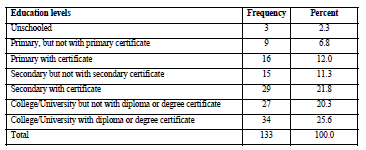
The table shows that 2.3% of parents were uneducated, 21.8% had secondary certificates, and 25.6% had received a college education and had a university degree certificate. The study indicates that lower education levels may make the parents not become active in assisting their children in attaining their education performance as they do not meet the developmental milestones within the EYFS framework. The teachers need to work collaboratively with the parents to ensure they understand the capabilities and abilities of the kinds and how they can help them.
Table 2: Teachers’ Education Level

The table shows that 100 percent of the teachers have university degrees indicating that they are highly trained. The findings show that the teachers provide the necessary support to the children at school in realizing their developmental goals.
Furthermore, as per the research queries, the study aimed to investigate the involvement of teachers and parents to ensure the achievement of the required partnership. The study focused on establishing how guardians and tutors interacted together and worked integrative in improving the child’s preschool education by realizing their developmental goals. In that regard, the teachers and parents were requested to give candid perceptions regarding how they engaged based on several modes of involvement, including parenting, communication, community collaborations, learning at home, decision-making, and volunteering. The table below indicates the general reported teacher-parent involvement level in each segment.
Table 3: General Parental Involvement Level
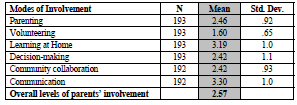
From the table, the overall parental involvement level stood at 2.57, which indicated that both the tutors and the guardians interacted to spearhead their partnership at’ sometimes.’ At the same time, learning at home and communication were reported as ‘often,’ while volunteering was recorded as ‘rarely. Furthermore, in their level of involvement, the parents were highly homogeneous, particularly regarding volunteering which reported a 0.60 standard deviation, and extremely heterogeneous in decision-making with a 1.07 standard deviation. The study findings indicate that despite the guardians having similar viewpoints on volunteering engagement, their perspectives varied significantly concerning the decision-making aspect.
Table 4: Overall Involvement of Parents as Recorded by Tutors and Guardians

From the above table, teachers reported parental involvement at 2.83, while the guardians reported parental engagement at 2.45. The means variation shows the parental involvement was between.04 and.80, indicating the partnership between them and that of the teachers was strong to ensure that the children met their developmental milestones.
Table 5: Overall Teachers’ Involvement Level
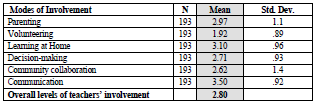
From the table above, the general involvement level of teachers stood at 2.80, indicating that ‘sometime’s they were incorporated in the teacher-parent partnership. However, learning at home and communication were recorded as ‘often,’ with other modes reported as ‘sometimes.’ However, volunteering recorded the lowest mean of 1.92, indicating that the teachers did not like to volunteer in their partnership with parents.
Table 6: General Teacher Involvement Level as Reported by Tutors and Guardians
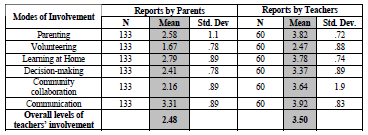
The overall mean score of 3.50 shows that tutors rated their involvement in spearheading teacher-parent partnership higher than the guardians’ ratings. The parents’ and teachers’ views varied significantly, mainly regarding parenting involvement.
Table 7: T-test on Teachers’ Involvement Level Reported by Sex

The study findings from the above table indicate no significant mean discrepancy concerning the entire involvement modes. The teacher involvement scores for male and female teachers were identical, and the 0.05 significance level across the partnership modes was accepted.
Study findings responded to the question of how the parent-teacher partnership facilitates children to attain their developmental milestones in early year education. The research used the defined roles of parents and teachers to manifest their impacts on developmental goals. In the partnership, there is what the parents need to do and not undertake for their children’s benefit.
Table 8: General Parents’ Role Definition Means
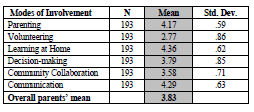
From the above table, the parents’ duty definition regarding their involvement in the parent-teacher partnership stood at 3.83. The studied phenomenon implies that the tutors and the guardians were not sure in their reporting concerning what the parents should be doing during the partnership. Such findings show that it becomes extremely difficult for the children to record improved developmental goals, as the parents are unaware of what they should do to help them.
Table 9: General Parents’ Role Definition Means as Reported by Tutors and Guardians
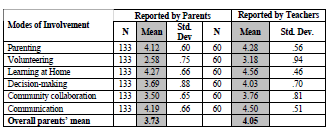
The above table shows the teachers recorded a general score of 4.05, while that of the parents was at 3.73. The teachers acknowledged the significance of the role of guardians in the partnership to impact the developmental objectives of their kids, although parents were unsure what to do. The parents agreed on their responsibility regarding learning at home, communication, and parenting, and they disagreed on the other modes of involvement. From the study findings, it was clear that the tutors understood the responsibility of the parents more than them due to their enhanced educational level. Based on the research question, the researchers wanted to establish how parent-teacher partnership acts to facilitate children in their early education. The kids’ developmental milestones cannot be realized when the parents do not know their responsibility.
Table 10: T-test on Parents’ Role Definition for Equality of Means
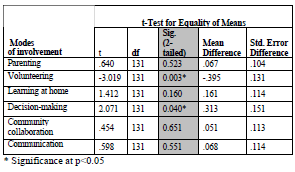
The above table shows the mean variations in the defined responsibilities for the guardians. The study results indicate a significant discrepancy in parents’ role definitions held by tutors and carers in the decision-making and volunteering means. There existed no significant mean variation regarding tutors’ and guardians’ perspectives on the role of parents in the involvement modes in facilitating their children to attain their developmental milestones during early childhood education. The study findings significantly culminated that they differed concerning parents’ defined roles in decision-making and volunteering. The study established the teachers supported the teachers on not being sure of their role in decision-making.
Table 11: Department of Education Officials and Headteachers Parent’s Role Definition Mean Scores
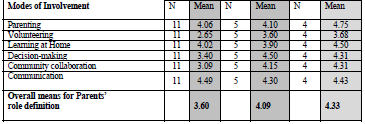
From the above table, the headteachers, district education board members, and the DfE officials’ overall mean scores stood at 3.60, 4.09, and 4.33, respectively. The study findings established that the DfE officials had the greatest means at the district level, implying that they had accepted and pinpointed various potential roles for parents. The study indicates that DfE officials mutually agreed that it was not the role of the guardians to be involved in volunteering.
Table 12: Parents’ Role Definition ANOVA computation
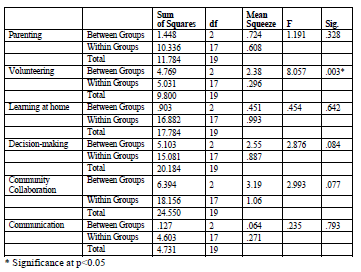
The table above showcased that the DfE officials had more knowledge regarding the role definition of guardians in parent-teacher partnership than the headteachers. There was a massive mean variation in the volunteering mode, which was not deemed the best involvement mode that can trigger the kids’ developmental milestones. Regarding volunteering, the headteachers’ mean was p=0.03<0.005, while that of the education officials was at p=0.03<0.05, showing the DfE officers had improved strategies to enhance parent-teacher partnership.
Discussion
Regarding the question which was sought to establish the effect of parent-teacher partnership on children’s education, the study findings show a weak involvement of parents. The literature previously had indicated that enhanced parent-teacher partnership advances the children’s emotional well-being, social competence, and academic achievement. However, from the available modes of involvement, the guardians are not well integrated into the affairs of their children generally, which may make them not attain their developmental milestones, thus attaining adverse educational outcomes. The study findings indicate involvement measures of volunteering, parenting, decision-making, communication, collaboration, and learning at home are not fully executed by the teachers, who have higher education backgrounds than the parents.
The research results rhyme with the earlier literature review that despite having policies in place in Britain, most preschools have not fully embedded the parent-teacher partnership in helping toddlers record positive developmental goals within the EYFS framework. The findings established poor or no parent-teacher relationship, which could negatively affect kids in attaining their physical, social, emotional, and cognitive developmental goals required for them to record positive performance in their education. However, the study found that the teachers involved parents in communication and learning at home to help their children when they are not in school. The parent-teacher partnerships from the findings were impacted by various factors, including the level of education, sex, and rural-urban contexts.
The study indicated that the parents did not know their defined role in the involvement in the parent-teacher partnership, particularly in decision-making, communication, and learning at home. The previous literature had indicated that the kid’s developmental milestones during early childhood education would deteriorate without a parent-teacher partnership. Without knowing the responsibilities in the child’s life, they cannot attain holistic developmental goals and increased performance attainment. The role of the parents helps in meeting the kid’s emotional, social, health, mental, and nutrition well-being. The study establishes that the teacher and the parents are not aware of communication responsibility regarding how to assist the kids who do not perform well due to adverse attitudes and conduct that impact their educational performance. The earlier literature review had indicated that other factors that massively impact children’s developmental milestones include nutrition, environment, health, and family. The study findings of parents not knowing their role during decision making and learning at home show that the tutors cannot provide extensive information on how to help children with homework and attached curriculum-associated activities.
The findings indicate that guardians and tutors do not work integratively at reinforcing learning, particularly at home, despite established strategies to promote parent-teacher partnerships. The literature review indicated that parenting skills are important in fostering the achievement of developmental goals of children during their early childhood education. An earlier study undertaken by other researchers had shown children spend approximately 75 percent of their hours outside the school, including weekends and holidays. Therefore, when the parents do not know their roles, they cannot provide conducive home surrounding that supports their kids’ education. In that case, rich-language development, guidance, inspiration, and parental expectations cannot be established as the parents do not know what to do.
The study found that preschool teachers are not adequately assisting parents in realizing their roles to engender child development and child-rearing abilities, despite having the increased education level. The literature review had indicated that for the children to attain the developmental milestones, the parents must act as the decision-makers, teachers, advocates, and supporters. The DfE officials from the study findings knew the best strategies to be adopted to enhance parent-teacher partnership and realize positive developmental milestones within the EYFS framework. The literature has spearheaded ways of involving tutors and parents, but not all of them have a positive impact on the guardians, such as volunteering.
Conclusions and Recommendations
Main Findings Summary
It was established that poor parent-teacher partnership existed, which was deemed not beneficial to children attaining developmental goals. The study findings established that should be adequate and improved communication, parenting, learning at home, decision-making, and collaboration for improved parent-teacher partnership. Communication was the most frequent mode of involvement for both teachers and parents, while volunteering was the least. In this study’s findings, the research participants, including DfE officials, the district board officers, and the headteachers, differed significantly regarding the parental role definition. As a result, the study showed that when the parents lack knowledge of what is expected of them, they cannot provide the required nutrition, health, favourable family interaction, and a conducive learning environment. The parent’s level of education negatively affected the parent-teacher partnership as they were not sure what to do to make their children attain their developmental milestones.
The findings established that some parents lacked adequate academic background, and others had primary and secondary education, with fewer having college and university degrees. All the teachers recorded 100 percent that they had received a university degree and were qualified at their task. In that case, they had shown similar views regarding all the involvement modes, including volunteering, decision-making, communication, collaboration, learning at home, and parenting. However, the study showcased that the poor parent-teacher partnership harms the child’s developmental milestones. The study found that the parents with little knowledge on what they should do did not offer guidelines, academic adverse and interact with their toddlers to ensure they build their seven key areas of the EYFS framework.
The research findings established that the teachers did not provide the necessary support to the parents concerning defining the role of the parents in partnerships. As a result, the early childhood education kids did not attain their developmental milestones, including imagination, reading, writing, listening, and managing self. The teacher’s environment, that is, urban and rural contexts, was not significantly different regarding the involvement of the parents. The findings established that the sex of the parent and the teacher varied substantially, particularly in the decision-making and learning at home. The female tutors and guardians tend to be more concerned about the welfare of their children by actively playing, interacting, and instilling good behaviour in them, as contrasted to their male counterparts.
The study found that how the guardians and the tutors defined parental responsibility significantly varied in the decision-making and volunteering. The DfE officials and district board officers differed in the volunteering aspect of involvement. It was concluded that volunteering was a traditional aspect that did not positively impact making parents handle their kids’ developmental objectives. The DfE officials and the headteachers differed significantly regarding the role of parents during early childhood education through their partnership with the teachers.
The primary take-home message from the investigation is that enhanced parent-teacher partnership can make kids realize their developmental milestones during early childhood education in the EYFS framework and spend more time with their parents. However, strategies, including decision-making, collaboration, parenting, communication, and learning at home, should be improved between the two parties for the children to benefit. The children’s work habits, interactions, and attitudes at home and in school depend on the parent-teacher partnership, which determines the educational outcomes. The DfE officials must work closely with the teachers and parents to make them choose appropriate strategies that can enhance their interaction for the children’s sake.
Limitations and Recommendations
The research had significant limitations, including that the study results can only be generalized to other populace with identical features. The research concentrated only on parent-teacher partnership from the perspectives of the DfE officials, the district board officers, the headteachers, and the preschool teachers. As a result, the viewpoints of the other educational stakeholders were not examined. Some of the study participants were suspicious that the research would be used for personal gains, and therefore the obtained findings might have been affected.
When integrated with the associated literature, the above findings offered a massive helpful database on what could be done to promote parent-teacher partnerships, mainly during the early childhood education in the Britain schools. Some of the noticeable implications are that the poor parent-teacher partnerships result in reduced educational outcomes for the children, making it difficult to realize their developmental milestones. The research findings indicated that the parents were not fully engaged in the decision-making concerning their kids’ education, thus affecting them not to perform exceptionally well academically. The parents’ behaviour and attitudes improve tremendously if the parental support becomes embedded in the parent-teacher partnership. An increased partnership improves parent comprehension and enhances teacher satisfaction, making guardians communicate with kids and ensuring they attain positive results in the school.
Significantly, a poor parent-teacher partnership results in a deteriorated family-school environment, which is not conducive to children. The kids require support to realize their developmental milestones, and this poor relationship makes them record poor academic results. There is a huge need for the schools to educate the parents on their role in supporting their kids within the EYFS framework to make them learn and develop effectively. According to the study, the schools that valued and respected parents despite their educational background made more efforts to support children, particularly outside the class hours.
One of the recommendations is that the DfE needs to examine the effects of partnership policy in the British preschools as the findings indicated a weak parent-teacher partnership. The phenomenon will assist in monitoring how the set relationship policies are executed and how they can be reinforced. The department of education requires preparing manuals and handbooks containing the aspects of decision-making, parenting, and learning at home to give the tutors and guardians adequate information regarding their essentiality (Smith et al., 2022). There should be a school empowerment program whereby the headteachers strengthen the parent-teacher relationships. The findings established that the teachers do not know the role of the parents in their partnership, which impacts the children’s developmental milestones. The research found that parents with minimal education background were less integrated into the partnerships. Therefore, it is highly recommended that the DfE conduct seminars, in-service courses, conferences, and workshops to sensitize them on parent-teacher partnerships, which currently was established to be poor.
Notably, the fathers and mothers were found to vary significantly in learning at home and parenting. It is highly suggested to enact and implement initiatives that will help parents increase their comprehension of the developmental needs of the kids, and guardians require to form committees to promote partnerships in schools. Further research suggests a need to study other factors that impact parent-teacher partnerships, including cultural differences, resources, language discrepancies, nature of work, and socioeconomic status. They tend to negatively impact parent-teacher partnerships, making the children unable to attain their developmental milestones within the EYFS framework during early childhood education.
Personal Reflections
In this research, what went well was the fact that all the research participants cooperated effectively and did not demand any compensation. The researcher obtained their informed consent, educated them on the purpose of the study, and insisted there were no personal interests. The things that did not go well included inadequate answering of the questionnaires by some respondents, thus spoiling the results of the findings. If the investigator had educated them on responding to the questionnaires, they would have found it easy to fill them. I have learned that poor parent-teacher partnership impedes children in attaining their developmental milestones. The research impacted the investigator by creating an extensive understanding and awareness of the research problem. Lastly, the researcher impacted the research by solving the research gap involving the effect of parent-teacher partnership in making the children attain their developmental milestones within the EYFS framework during early childhood education.
Reference List
Adams, D., Harris, A., and Jones, M.S. (2018) ‘Teacher-parent collaboration for an inclusive classroom: Success for every child,’ MOJES: Malaysian Online Journal of Educational Sciences, 4(3), pp. 58-72. Web.
Armstrong, D. (2020) Power and partnership in education: Parents, children, and special educational needs, pp. 1-340. Routledge. Web.
Bilton, R., Jackson, A. and Hymer, B. (2018) Cooperation, conflict, and control: Parent-teacher relationships in an English secondary school. Educational Review, 70(4), pp. 510-526. Web.
Britto, P.R, et al. (2017) ‘Nurturing care: promoting early childhood development, ‘The Lancet, 389(10064), pp.91-102. Web.
Cantor, L.M. and Roberts, I. F. (2021) Further education in England and Wales. United Kingdom: Routledge.
Cook, K.D., Dearing, E. and Zachrisson, H.D., 2018) ‘Is parent-teacher cooperation in the first year of school associated with children’s academic skills and behavioral functioning?’ International Journal of Early Childhood, 50(2), pp.211-226. Web.
Đurišić, M. and Bunijevac, M. (2017) ‘Parental involvement as an important factor for a successful education,’ Center for Educational Policy Studies Journal, 7(3), pp.137-153. Web.
Emerson, R.W. (2017) ‘ANOVA and t-tests.,’ Journal of Visual Impairment & Blindness, 111(2), pp.193-196. Web.
German, S. (2018) ‘Forming parent-teacher relationships around three-dimensional learning,’ Science Scope, 42(1), pp. 26-28. Web.
Hamlin, D. and Flessa, J. (2018) ‘Parental involvement initiatives: An analysis,’ Educational Policy, 32(5), pp.697-727. Web.
Helgetun, J.B. and Menter, I. (2022) ‘From the age of measurement to an evidence era? Policy-making in teacher education in England,’ Journal of Education Policy, 37(1), pp.88-105. Web.
Hornby, G. and Blackwell, I. (2018) ‘Barriers to parental involvement in education: An update,’ Educational Review, 70(1), pp.109-119. Web.
Hryniewicz, L. and Paulette, L. (2020) Partnership with parents in early childhood settings: Insights from five European countries. Routledge. Web.
Jeynes, WH (2018). ‘A practical model for school leaders to encourage parental involvement and parental engagement,’ School Leadership & Management, 38(2), pp.147-163. Web.
Lang, S.N., Jeon, L., Schoppe-Sullivan, S.J. and Wells, M.B. (2020) ‘Associations between parent-teacher caring relationships, parent-child relationships, and young children’s social-emotional development, ‘In Child & Youth Care Forum, 49(4), pp. 623-646. Springer US. Web.
Myende, P.E. and Nhlumayo, B.S. (2022) ‘Enhancing parent-teacher collaboration in rural schools: Parents’ voices and implications for schools,’ International Journal of Leadership in Education, 25(3), pp.490-514. Web.
Palaiologou, I. (2021) The early years’ foundation stage: Theory and practice, pp. 27-167. Sage.
Richter, L.M, et al. (2017) ‘Investing in the foundation of sustainable development: pathways to scale up for early childhood development,’ The Lancet, 389(10064), pp.103-118. Web.
Torres-Rendón, L. and Zinsser, K.M. (2022) ‘Predictors of parent-teacher relationship quality in head start classrooms,’ HS Dialog: The Research to Practice Journal for the Early Childhood Field, 25(1). Web.
Tashakkori, A. and Teddlie, C. (2021) Sage handbook of mixed methods in social & behavioural research, pp. 25-37. SAGE publications.
Sheldrick, R.C., Schlichting, L.E., Berger, B., Clyne, A., Ni, P., Perrin, E.C. and Vivier, P.M. (2019) ‘Establishing new norms for developmental milestones,’ Paediatrics, 144(6). Web.
Sheridan, S.M., Knoche, L.L. and Boise, C. (2022) Getting ready: A relationship-based approach to parent engagement in early childhood education settings. In Family-School Partnerships During the Early School Years, pp. 17-31. Springer, Cham.
Sheridan, S.M., Knoche, L.L. and White, A.S. (2019) Family-school partnership in early childhood education: Exemplars of evidence-based interventions. Edited by Sheldon Steven and Turner-Vorbeck, Tammy. The Wiley Handbook of Family, School and Community Relationships in Education, pp.1-719. John Wiley & Sons.
Smith, T.E., Holmes, S.R., Romero, M.E., and Sheridan, S.M. (2022) ‘Evaluating the effects of family-school engagement interventions on parent-teacher relationships: A Meta-analysis,’ School Mental Health, pp.1-16. Web.
Willig, C. and Rogers, W.S. (eds). (2017) The SAGE handbook of qualitative research in psychology, pp, 1-15. Sage.
